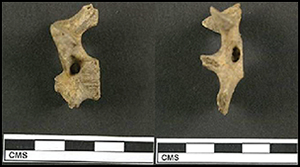Crossref Citations
This article has been cited by the following publications. This list is generated based on data provided by
Crossref.
Madgwick, Richard
and
Mulville, Jacqui
2015.
Reconstructing depositional histories through bone taphonomy: extending the potential of faunal data.
Journal of Archaeological Science,
Vol. 53,
Issue. ,
p.
255.
Roberts, Benjamin W.
Boughton, Dorothee
Dinwiddy, Michael
Doshi, Nisha
Fitzpatrick, Andrew P.
Hook, Duncan
Meeks, Nigel
Mongiatti, Aude
Woodward, Ann
and
Woodward, Peter J.
2015.
Collapsing Commodities or Lavish Offerings? Understanding Massive Metalwork Deposition at Langton Matravers, Dorset During the Bronze Age–Iron Age Transition.
Oxford Journal of Archaeology,
Vol. 34,
Issue. 4,
p.
365.
Madgwick, Richard
2016.
New light on feasting and deposition: exploring accumulation history through taphonomic analysis at later prehistoric middens in Britain.
Archaeological and Anthropological Sciences,
Vol. 8,
Issue. 2,
p.
329.
Davis, Oliver
2017.
Filling the Gaps: The Iron Age in Cardiff and the Vale of Glamorgan.
Proceedings of the Prehistoric Society,
Vol. 83,
Issue. ,
p.
325.
Rowley-Conwy, Peter
2018.
Zooarchaeology and the elusive feast: from performance to aftermath.
World Archaeology,
Vol. 50,
Issue. 2,
p.
221.
Lodwick, Lisa A.
2018.
Arable weed seeds as indicators of regional cereal provenance: a case study from Iron Age and Roman central-southern Britain.
Vegetation History and Archaeobotany,
Vol. 27,
Issue. 6,
p.
801.
Mainland, Ingrid
and
Batey, Colleen
2018.
The nature of the feast: commensality and the politics of consumption in Viking Age and Early Medieval Northern Europe.
World Archaeology,
Vol. 50,
Issue. 5,
p.
781.
Dozier, Crystal A.
2019.
Evidence of feasting in the Southern Plains: Maintenance and reinforcement of the Toyah social field, 1250–1650 AD.
Plains Anthropologist,
Vol. 64,
Issue. 251,
p.
275.
Madgwick, R.
Lamb, A. L.
Sloane, H.
Nederbragt, A. J.
Albarella, U.
Pearson, M. Parker
and
Evans, J. A.
2019.
Multi-isotope analysis reveals that feasts in the Stonehenge environs and across Wessex drew people and animals from throughout Britain.
Science Advances,
Vol. 5,
Issue. 3,
Worley, Fay
Madgwick, Richard
Pelling, Ruth
Marshall, Peter
Evans, Jane A.
Lamb, Angela L.
López-Dóriga, Inés L.
Bronk Ramsey, Christopher
Dunbar, Elaine
Reimer, Paula
Vallender, John
and
Roberts, David
2019.
Understanding Middle Neolithic food and farming in and around the Stonehenge World Heritage Site: An integrated approach.
Journal of Archaeological Science: Reports,
Vol. 26,
Issue. ,
p.
101838.
Evans, Jane
Parker Pearson, Mike
Madgwick, Richard
Sloane, Hilary
and
Albarella, Umberto
2019.
Strontium and oxygen isotope evidence for the origin and movement of cattle at Late Neolithic Durrington Walls, UK.
Archaeological and Anthropological Sciences,
Vol. 11,
Issue. 10,
p.
5181.
Rahmstorf, Lorenz
2019.
Scales, weights and weight-regulated artefacts in Middle and Late Bronze Age Britain.
Antiquity,
Vol. 93,
Issue. 371,
p.
1197.
Waddington, Kate
Bayliss, Alex
Higham, Thomas
Madgwick, Richard
and
Sharples, Niall
2019.
Histories of deposition: creating chronologies for the Late Bronze Age–Early Iron Age transition in Southern Britain.
Archaeological Journal,
Vol. 176,
Issue. 1,
p.
84.
Schulting, Rick J.
le Roux, Petrus
Gan, Yee Min
Pouncett, John
Hamilton, Julie
Snoeck, Christophe
Ditchfield, Peter
Henderson, Rowena
Lange, Priscilla
Lee-Thorp, Julia
Gosden, Chris
and
Lock, Gary
2019.
The ups & downs of Iron Age animal management on the Oxfordshire Ridgeway, south-central England: A multi-isotope approach.
Journal of Archaeological Science,
Vol. 101,
Issue. ,
p.
199.
Madgwick, Richard
Grimes, Vaughan
Lamb, Angela L.
Nederbragt, Alexandra J.
Evans, Jane A.
and
McCormick, Finbar
2019.
Feasting and Mobility in Iron Age Ireland: Multi-isotope analysis reveals the vast catchment of Navan Fort, Ulster.
Scientific Reports,
Vol. 9,
Issue. 1,
Bradley, Richard
2019.
The Prehistory of Britain and Ireland.
Fitzpatrick, A
Bond, J
Büster, L
and
Armit, I
2020.
A brief consideration of the later prehistoric appearance and possible significance of the great auk (Pinguinus impennis) in the Covesea Caves of north-east Scotland.
The Glasgow Naturalist,
Vol. 27,
Issue. 2,
p.
79.
Faillace, Katie E.
Foody, M. George B.
and
Madgwick, Richard
2020.
Exploring the potential of TEM analysis for understanding cooking at prehistoric feasting sites.
Scientific Reports,
Vol. 10,
Issue. 1,
BRÜCK, JOANNA
and
BOOTH, THOMAS J.
2022.
The Ambivalent Dead: Curation, Excarnation and Complex Post-mortem Trajectories in Middle and Late Bronze Age Britain.
Proceedings of the Prehistoric Society,
Vol. 88,
Issue. ,
p.
193.
Perry-Gal, Lee
Ktalav, Inbar
Nadav-Ziv, Liat
and
Haddad, Elie
2022.
Pigs in a pit: An unusual find of ritual suid exploitation in an Early Islamic context at the site of Tel Yavne, Israel.
Journal of Archaeological Science: Reports,
Vol. 43,
Issue. ,
p.
103462.
